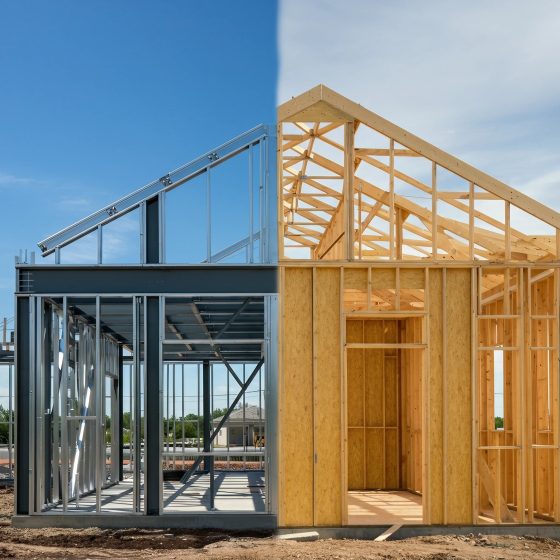
Table of Contents
Last Updated on December 18, 2024 by John Patterson
If you are in the process of building a home or structure, one of the most critical decisions you will make is what framing material to use. Steel framing and wood framing are among the most commonly used materials and both have their own strengths and weaknesses based on the project.
This guide outlines the major differences between steel framing, and wood framing, the pros and cons of each, and ideal use cases.
Why Framing Materials Matter?
Your choice of framing material matters more than logistics—it’s fundamental to the integrity of your structure. From cost and durability to aesthetics and environmental impact, the material you use for framing plays a role during almost every construction stage.
Both steel framing and wood framing offer unique qualities. To make a sound choice, you have to consider the specifics — resistance, longevity, ease of installation, return on investment, and so on.
What is Steel Framing?
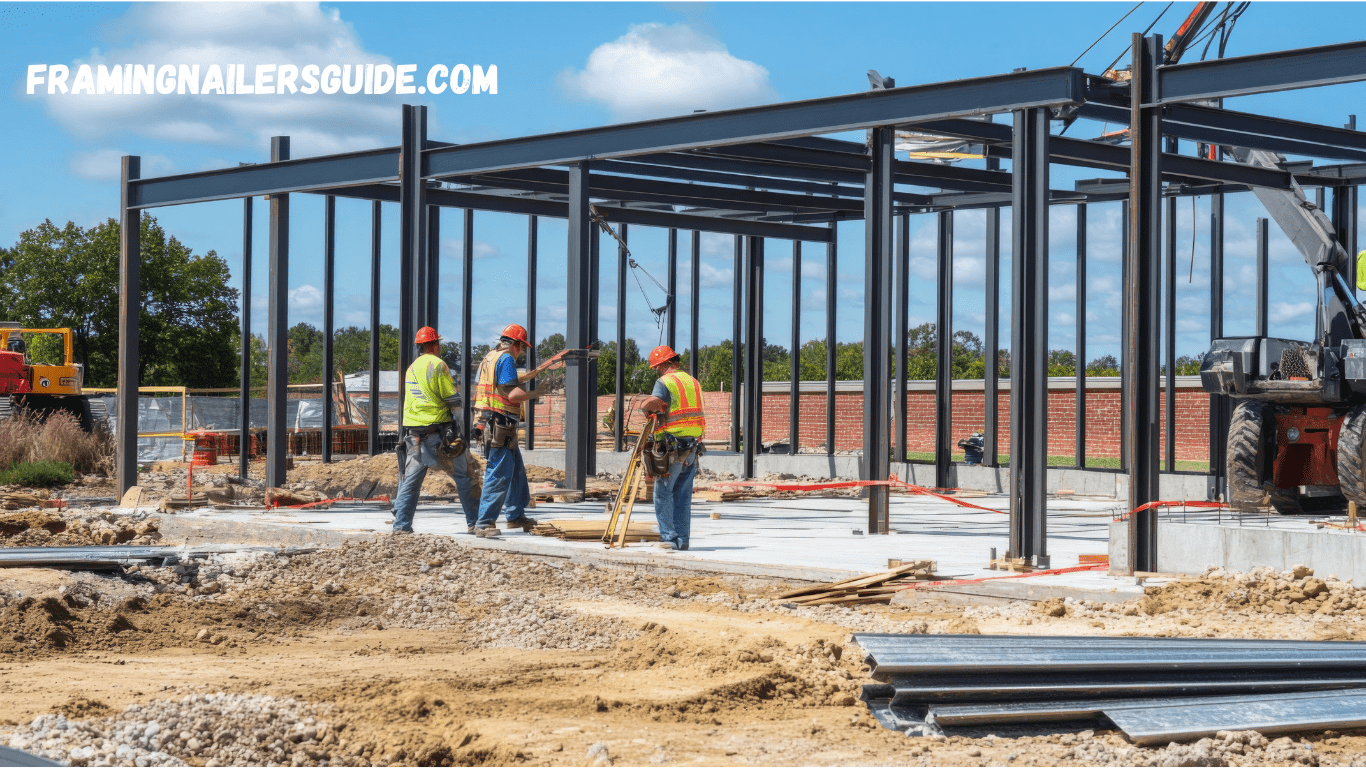
Steel framing: Metal beams and studs make up the skeleton of a structure. Steel framing is most commonly used in commercial buildings and warehouses as well as becoming a more common choice for residential homes as well. It is a durable and resilient material choice that has unique advantages for contemporary projects.
Advantages of Steel Framing
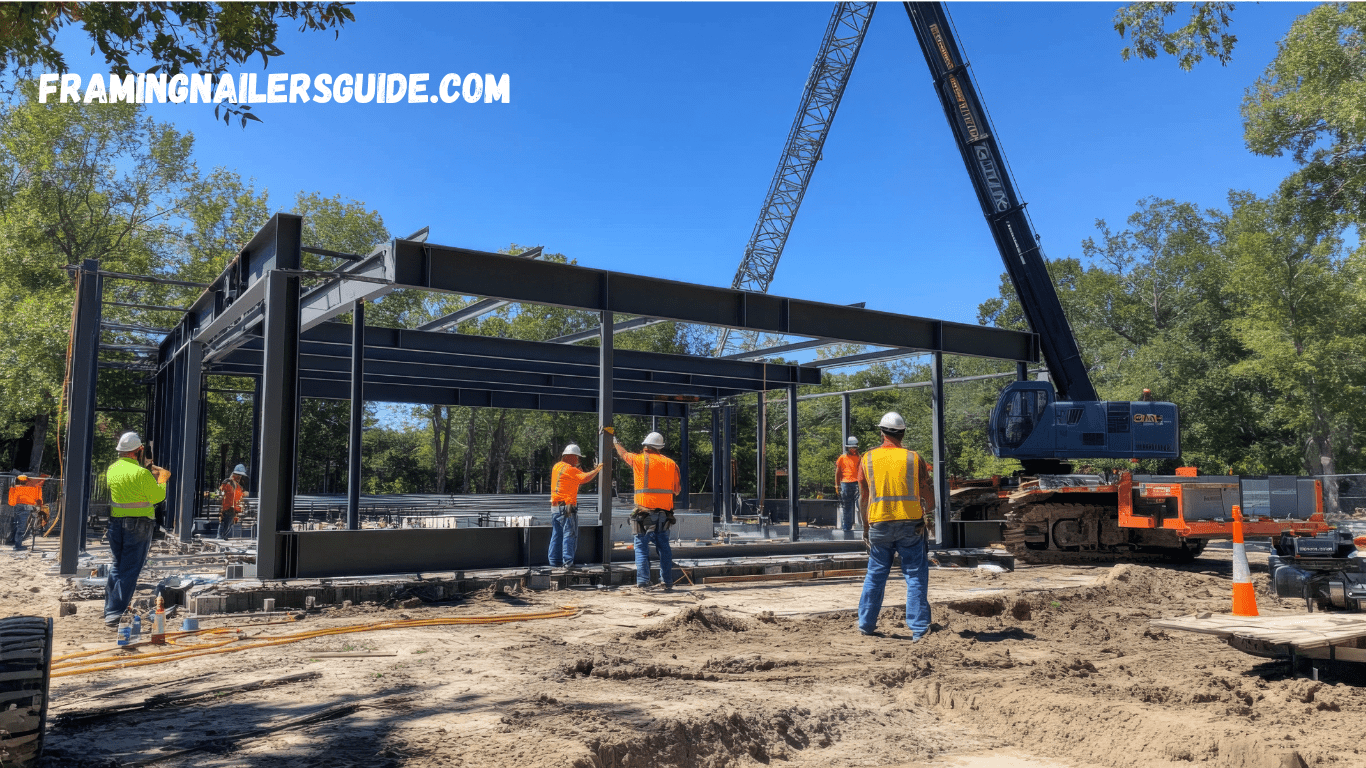
The reason why steel framing is very unique is due to its durability and also is resistant to outer factors that can endanger a structure’s integrity. It has particular appeal in climates where weather can be harsh on wood or other common materials.
Pros of Steel Framing
Warp- and Rot-Resistant: Steel does not swell, warp, or rot in contact with water or as the environment changes as wood does.
Fire-Resistant: Steel is non-combustible, making it a safer choice for building in areas that are prone to fire. This property also increases its overall safety rating for residential and commercial buildings.
Pest-Resistant: Steel framing won’t fall prey to termites, carpenter ants or beetle infestations, which are a common problem with wood framing.
Lightweight: Though steel has high tensile strength, it is light-weight — which improves transportation and job site handling of the materials.
Here are some of the disadvantages of Steel Framing
It’s not that steel framing doesn’t have strengths — it does — but that it also has limitations (your framework doesn’t say what those are). These challenges may thus become a factor into your decision as it relates to the particular project and location.
Cons of Steel Framing
Not a Good Insulator: Steel is a great conductor, both of heat and cold, which results in higher energy costs if you don’t put insulation in or around it.
Heat Conductor: Because steel can hold in heat, you may need extra fireblocking measures.
Reduced Workability: Due to the attributes of steel as compared to wood, it can often be more difficult to work with to achieve custom architectural building projects.
Rust Development: Steel in a humid and coastal environment may corrode after a while when not coated or treated.
What is Wood Framing?
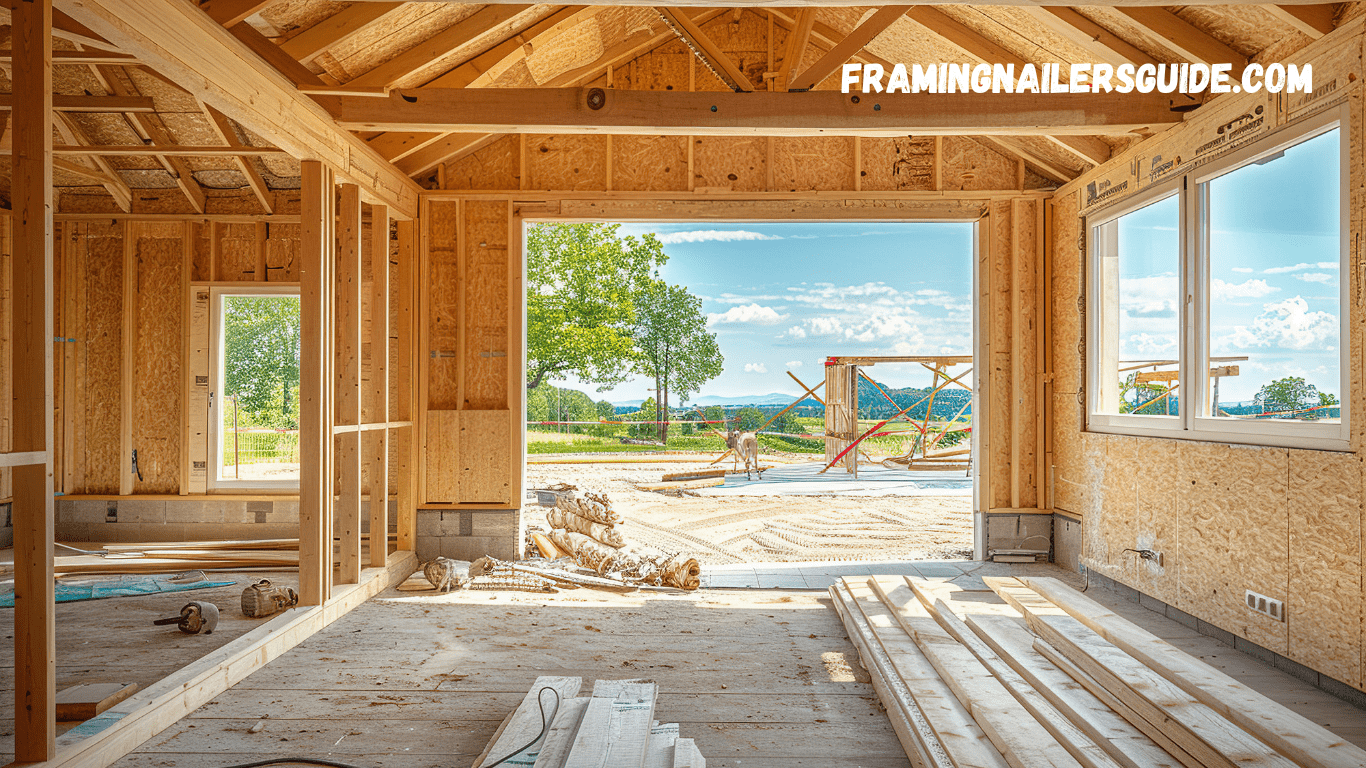
Wood framing is a classic method that has been part of home construction for a long time. It uses lumber to build the framework of the structure and is still especially prevalent in residential construction projects in the United States and Canada.
Advantages of Wood Framing
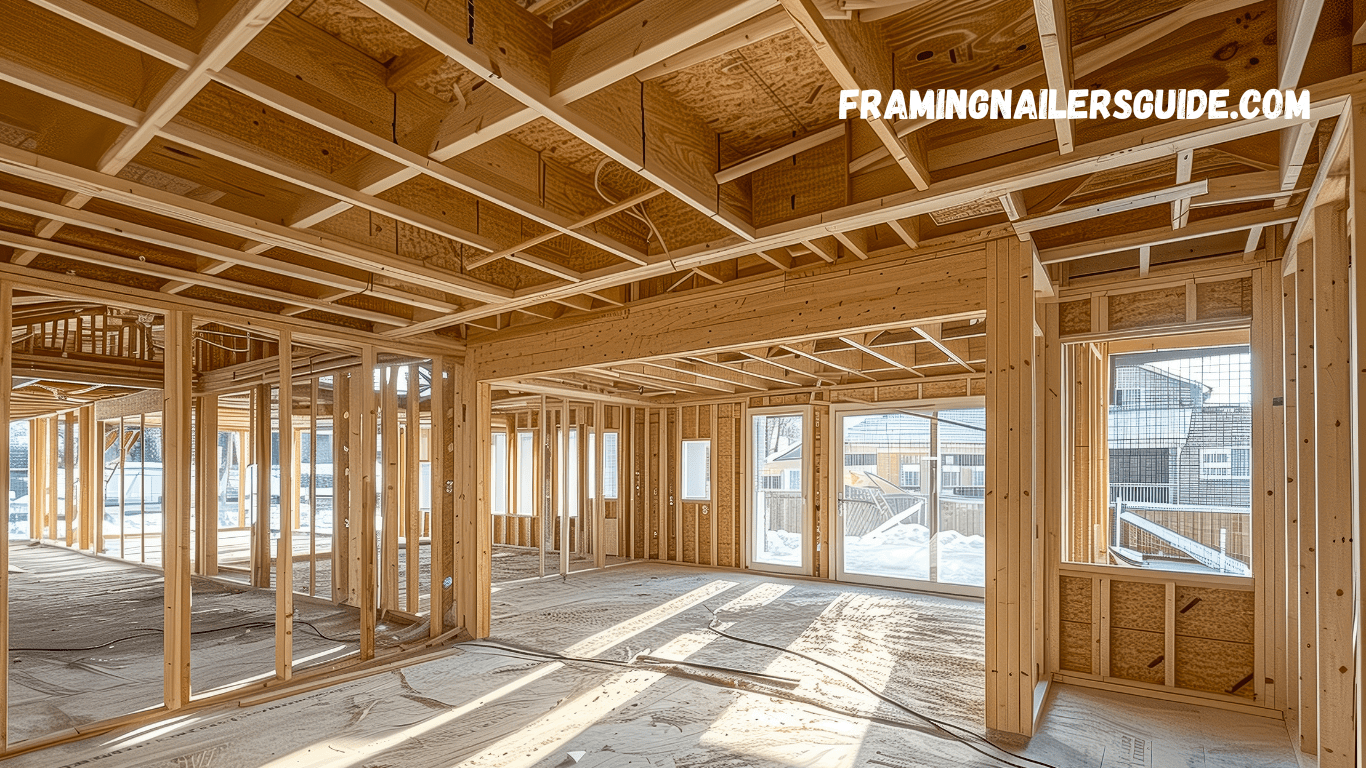
Wood is readily available and provides a cost-effective option for builders and renovators. Firstly and most importantly, because its natural properties provide insulation and adaptability, its excellent performance characteristics match with custom home projects or smaller constructions.
Pros of Wood Framing
Easily Accessible: Wood is readily found and simple to acquire, rendering it a practical option for numerous builders.
More Contractors Know How to Do It: Wood-framed construction is much more common than steel, so there are significantly more contractors familiar with how to build a wood frame than a steel one.
Versatile: Wood is easy to cut and shape, making the design more flexible when homes are built.
Doesn’t Conduct Electricity: Thanks to its natural insulating properties, wood will not pose electrical hazards.
Natural Insulator: Wood keeps houses warm, helping reduce energy costs and usage in colder climates.
Disadvantages of Wood Framing
Though it’s one of the most common materials in use today, wood framing isn’t without its challenges, particularly when it comes to durability and maintenance.
Cons of Wood Framing
Flammable: Wood is highly flammable, making it less than ideal in wildfire-prone regions or regions with stringent fire safety codes.
Warp & Rot due to Moisture: The moisture changes can lead wood to become expanded, warped or rot after a while.
Vulnerable to Pest/Infestation: If not properly treated or targeted, termites and other pests could destroy the wood frame of the building.
Requires More Upkeep: Wood framing will require periodic inspection and treatment to ensure it stays in proper condition.
May Cause Structural Problems: Over time, wood becomes weaker or may shift and cause potential structural stability issues.
Complete Analysis of Steel Framing vs Wood Framing
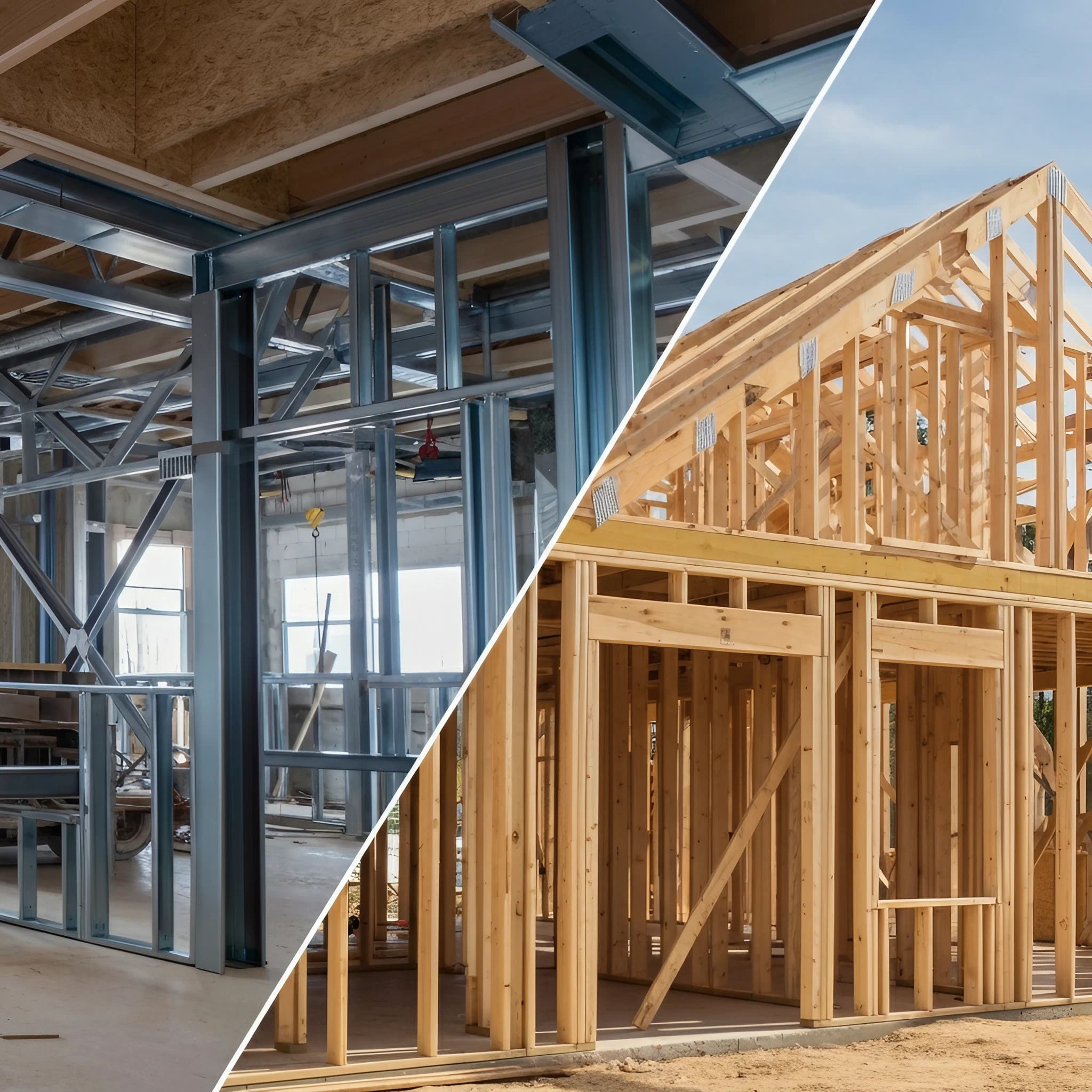
Now that we’ve detailed the pros and cons of each framing material, let us compare the two, side by side.
Cost
Metal Framing: Higher initial investment based on materials, as well as tools needed for assembly.
Wood Framing: Usually more affordable, materials are more readily available and labor is more cost-effective.
Durability
Steel Framing: Durable and immune to fire, moisture, and pests.
Wood Framing: Needs consistent maintenance and is prone to environmental factors.
Availability
Steel Framing: Not as readily available as wood; may require importing in some regions.
Wood Framing: Readily available at most local lumberyards or home improvement centers.
Integrity
Steel Framing: Avoids warping, sagging and settling for a framework that won’t give way.
Wood Framing: Changes and vulnerabilities over time could mean high maintenance to ensure overall integrity.
Sustainability
Steel Framing: Recyclable but also often energy-intensive to produce.
Wood Framing: Renewable, biodegradable, and more environmentally friendly building material—if harvested sustainably.
Versatility
Steel Framing: Best for large-scale projects, poor for intricate or custom designs
Wood Framing: Adaptable, easy to change on-site—during construction.

| Feature | Steel Framing | Wood Framing |
|---|---|---|
| Thermal Performance | Needs extra layering to avoid temperature transfer. | Great insulators, and often more energy-efficient. |
| Cost | Higher upfront cost. | Lower high entry cost. |
| Durability | Firm against fire, vermin, and mold. Very long lifespan. | Termites, rot, and fire prone Requires more maintenance. |
| Sustainability | These vessels are often made from recycled steel and are 100% recyclable. | Renewable resource, but dependent on sustainable forestry |
| Ease of Installation | The above requires specialized skills and or equipment | User friendly and commonly used by contractors. |
| Design Flexibility | Best for open-concept or industrial looks. | It can be easily customized for detailed work. |
| Lifespan | Lasts for decades with responsible use. | Lifespan is shorter; requires more often repairs. |
Frequently Asked Questions
Steel framing, or framing with aluminum or even glass, is better than wood?
There’s no catchall answer.” Steel framing is durable and fire-resistant while wood framing is cost-effective and more versatile. When deciding which one to follow these lines train on the specific needs of your project.
I have a strong position behind glass. What other substrates could I use for framing?
Laminated veneer lumber (LVL), concrete, and aluminum are other frequently used materials. Modern construction is also favouring hybrid framing systems that are composite in nature.
Is steel framing a greener building system than wood framing?
Steel is recyclable, but it takes a lot of energy to produce. On the other hand, wood is a renewable material and decomposes naturally, but only if it is obtained from sustainable sources and managed sustainably.
How long does a steel frame last compared to a wood frame?
Steel framing lasted 100+ years with proper maintenance, whereas wood framing needed more upkeep and may have a shorter lifespan in moisture-prone or pest-heavy regions.
Selecting the Ideal Framing Material for Your Project
Both steel framing and wood framing have their own strengths and challenges. Which one you end up going for mostly depends on your project need, budget and weather conditions. Steel is the one that gives Push push resistance and the utmost durability, and wood is the one that provides flexibility, cost, and natural insulation.
Still unsure? Talk to a contractor about what framing material makes sense for your building. Being deliberate about the cost-benefit analysis of your project will make sure your project lasts.

